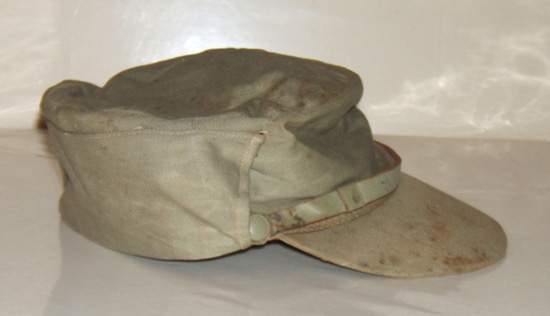
Side view of the Hitelmacher. Even more appealing when it retains a straight shape. (Collection of Alex Ben-Arieh/Historama.com)
Though the Israeli Army earned glory on the battlefield in 1948, it came into being during a period where militaria started to lose its national uniqueness. Under the influence of Eastern and Western alliances, and more efficient production processes, armies began to adopt homogeneous, if boring, accessories and equipment such as mass-made nylon patches, conventional uniforms and plain, generic helmets.
During the 1947-49 War of Independence, the Israeli Defense Forces (IDF) and its forerunners sported ‘sock hats’ (“Kova Gerev” – in Hebrew) from local manufacture or leftover British Army stocks. However the army also succeeded in receiving a uniquely styled hat in sufficient quantities that its presence also left its mark on the identity of the army: the ‘Hitelmacher’ hat. The Hitelmacher bears a semblance to a kepi in the style of a Finmark hat, but when affixed with the Army’s emblem, it also exhibits a ceremonial elegance.
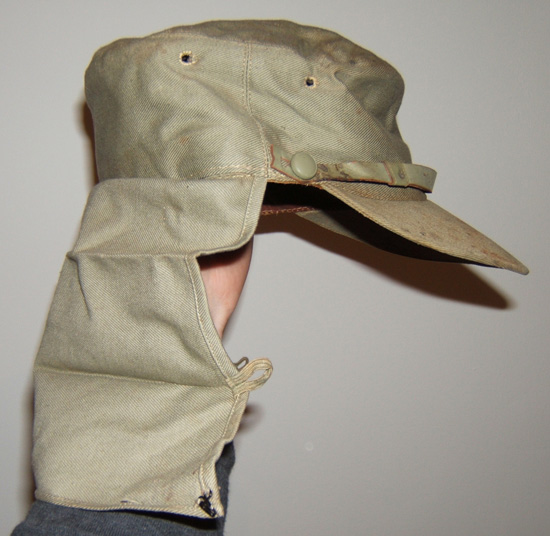
The Hitelmacher with the sides dropped-down, as when used in service. Notice the metal hook and elastic band on the flap which would hold the flaps in place when folded up. (Collection of Alex Ben-Arieh/Historama.com)
Available information on the hat’s origins is difficult to locate, however from what is known, in 1947 the Transitional Government in the Jewish areas of Palestine placed orders for hats with manufacturers in New York. The original style which was subsequently produced and supplied was made by a firm bearing the Yiddish word for ‘hat-maker’ – “Hitelmacher” – and hats of this style then and since have come to be known here as “Hitelmacher” hats.
These kinds of hats were originally produced in the United States, and later in Israel. Their uniqueness is in their practicality, quality of manufacture and style: a straight-sided round hat with a firm visor, leather chin strap and sweat bands and drop down cloth back to protect the wearer’s neck, all held together with strong stitching.
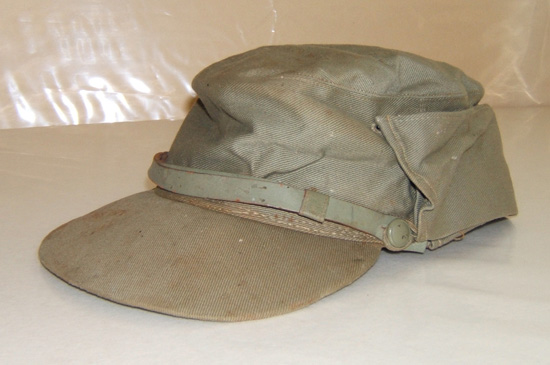
A frontal view of the hat, with leather chin-strap and buttons visible. (Collection of Alex Ben-Arieh/Historama.com)
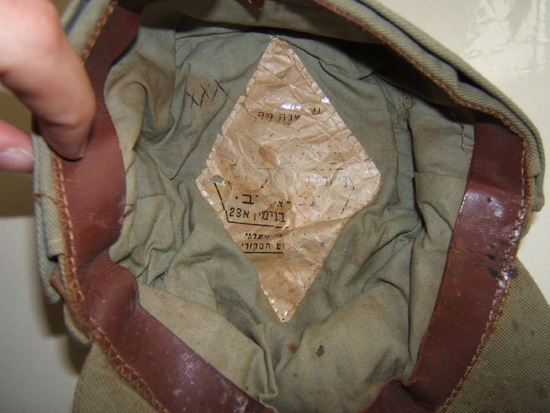
The inside of the hat with maker’s label visible. Notice also the stitching work on the sweatband and the type of liner used inside. (Collection of Alex Ben-Arieh/Historama.com)
In light of the lack of available information on styles and appearances I can only rely on photographic examples and experience: there existed at least two widely distributed color varieties of these hats – one with khaki denim and a black leather chin-strap, with stitch lines on the visor (the American variety), and a light-green denim version with a green leather chin-strap and plain denim visor (the version here; an Israeli make). Other varieties are also likely as photographs illustrate types with thicker, firmer fabric or others with both fabric and chin-straps in khaki. So far, I have not found any consistency as to the wearing of these styles (or of variations in their accouterments).
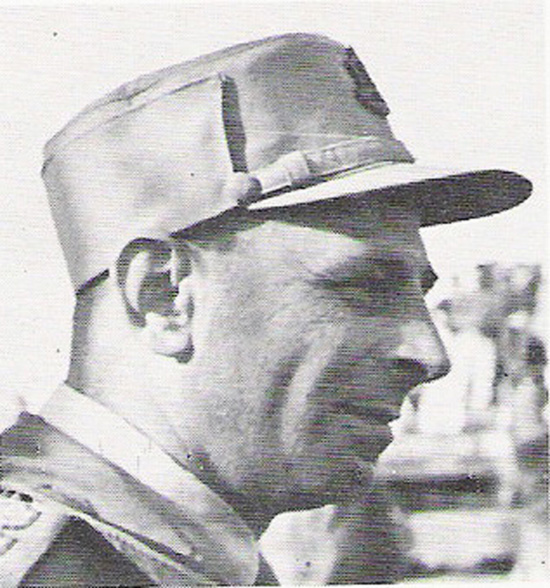
One version of the Hitelmacher as worn by Col. Tsvi Ayalon, head of Central Command in 1948. His hat and chin strap are all in one color (probably khaki), but the fabric does not look like denim and the cord doesn’t look like leather. Notice the plain buttons, and also the IDF’s metal insignia affixed to the front of his hat. Early insignia on these hats was also a cloth representation of the IDF’s insignia – though much scarcer to see.
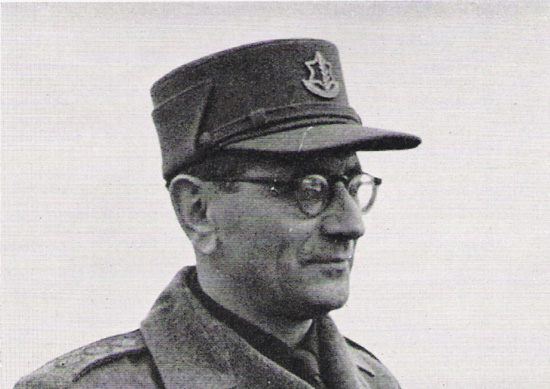
Another more rare type of Hitelmacher as worn by Col. David Shaltiel, the commander of Jerusalem during the War of Independence. Formerly of the French Foreign Legion, Shaltiel wears a version of the Hitelmacher quite similar to a French kepi – straight and stiff-looking, with shorter, slanted side-flaps. The fabric looks thicker than that of other such hats. Though there could be ‘dress’ hats Shaltiel’s is the only such example of this Hitelmacher that the author has seen.
Although the IDF wore light-green caps of various types through to the 2000s, photographs suggest that the Hitelmacher hat was worn up until around the 1956 Sinai Campaign (“Operation Kadesh”). The example shown here seems to be from the early to mid-1950s: inside it is stamped with the Hebrew letter “Tet” and the number “55” (although the standard stamp bearing the IDF’s first initial “Tz” – for “Tzahal” – is not present). The “Tet” is probably the hat size, and the “55” may correspond to the date of issue – 1955.
In spite of its simple appearance, the hat is full of interesting details. The deteriorating maker’s label inside indicates that it was made on Nachlat Binyamin Street in Tel Aviv – an Israeli manufacture. An interesting detail is the plain green non maker marked buttons holding down the chin-strap on each side. Buttons on Israeli military hats in the early 1950s, but also in the late ’40s, also bore the embossed emblem of the IDF – with and without maker-marks, and a photograph of the second Israeli Chief of the General Staff, Yigal Yadin, from around 1948 shows his Hitelmacher hat bearing those such buttons. Therefore it’s curious to see a possibly late-dated hat without decorated buttons.
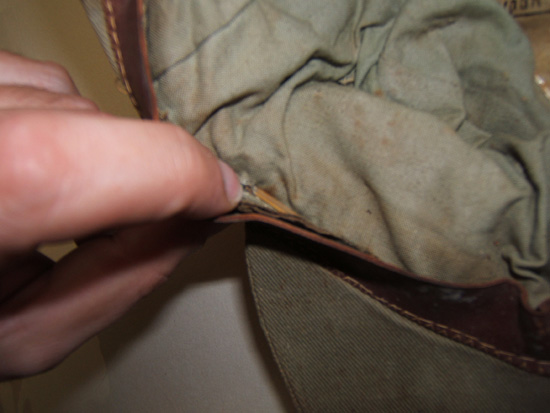
A close-up of the thin light-orange plastic pin fastened to the back of one of the buttons, probably to hold it in place more firmly. It also helps the hat retain its shape along the side. (Collection of Alex Ben-Arieh/Historama.com)
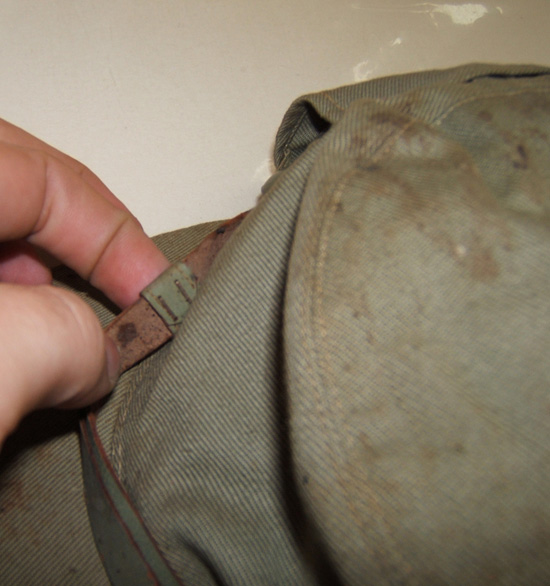
A close-up of the staples holding the chin-strap’s ‘knot’ in place. Also notice the fine stitch work of the various segments of the hat. (Collection of Alex Ben-Arieh/Historama.com)
The leather chin-strap’s ‘knots’ are held in place by two metal staples. On the inside, the buttons which fasten the strap are themselves held in place by an inch-long thin, light orange plastic pin. Unlike on other visor hats, the four air holes on the Hitelmacher are formed from tightly stitched circles and not from the insertion of a plastic framed loop.
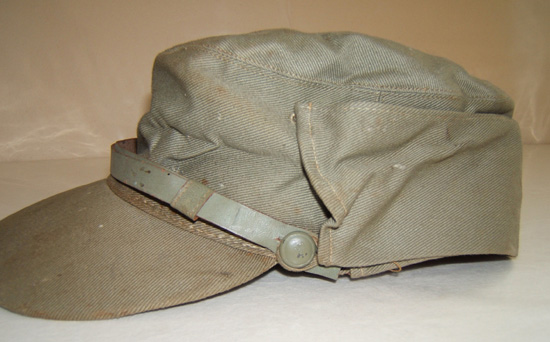
A closer view of the plain green buttons. (Collection of Alex Ben-Arieh/Historama.com)
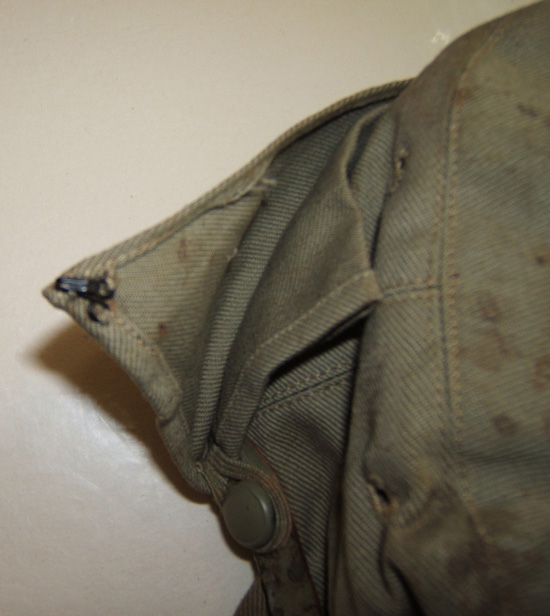
A close-up of the black colored metal hook on the upper corner of the flap. In the background is visible the green elastic band on the bottom corner of the flap hooked over the button. (Collection of Alex Ben-Arieh/Historama.com)
Another interesting detail is the metal fastening hook on each corner of the drop-down cloth sides: this hat has black colored hooks; other versions of this green styled hat sport silver colored hooks. These hooks would latch onto the first air-hole at the front of the hat in order to hold the flaps in place. This hat also has green elastic bands on the bottom ends of the drop down sides (which would be wrapped over the buttons to keep the sides up); other versions of this hat have creme-colored bands instead.
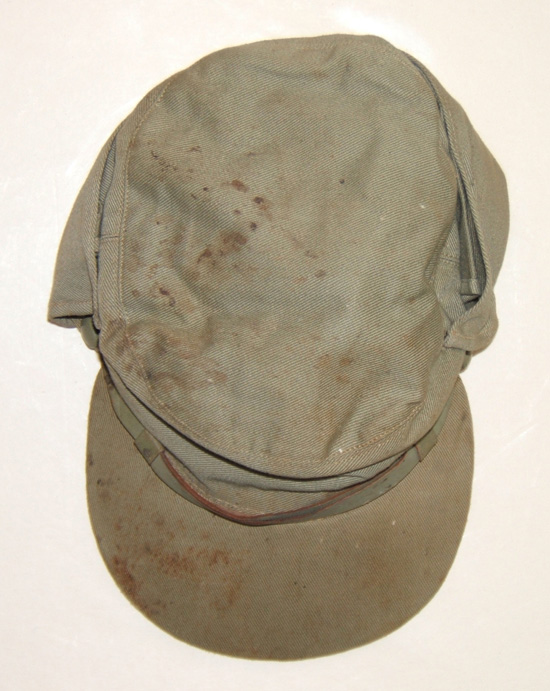
Alex Ben-Arieh
March 2016
This article originally ran on The Historama. Our thanks to our friend Alex Ben-Arieh for allowing us to re-publish this article.

Why these ‘Hitelmacher’ Hats were abolished?
Probably economy , the Hitelmacher looks as a fine piece of headgear , good materials and time consuming to make .
David Shaltiel learned military into the french Legion , he was a orthodox and conservative chief ,very smart dressed ever the french author Dominique Lapierre and his pal Larry Collins saids : Shaltiel s idea of an Army officer was closer to a Saint Cyrien with white gloves rather than a rag tag little officer of the Palmach without the minor sense of discipline
Probably economy , the Hitelmacher looks as a fine piece of headgear , good materials and time consuming to make .